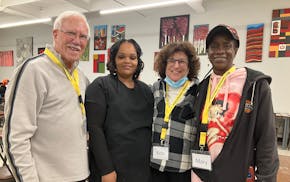A boiled egg, stray pins and stringy black fishing tackle met their end, contained in a small, amber-tinted resin cube atop a miniature trophy head. The winner's name has been scribbled out with permanent marker.
After its transformation from trophy to art object, German artist Michaela Eichwald named this oozing amalgamation "Benny Hill im Magendoktor (Benny Hill at the Magendoktor)," a reference to the slapstick, sometimes smutty British comedian and to a popular dive bar near the artist's Berlin home.
This is one of 20 paintings, sculptures and collages in Michaela Eichwald's first U.S. solo museum show, which opened Saturday at Walker Art Center. The exhibition spans works created over the past 10 years. The sometimes gloopy, sometimes glistening works are arranged in the wide-open, white-walled Burnet Gallery, which has been divided in two for this show.
Her poet/writer friend Ulf Stolterfoht wrote one long poem in response to the titles of her works. It is divided into nine sections and interspersed throughout the exhibition.
"With Michaela, I see a few things," said curator Pavel Pyś. "One is the desire to question the limits of good taste — what is kitsch? What is a good versus a bad painting? — and that tension between attraction and repulsion."
Somewhere in the murky space between abstraction and figuration, Eichwald's paintings are mostly either long, horizontal rectangles, like scrolls read left to right, or vertical rectangles shaped like apartment building windows.
She paints predominantly on pleather, an artificial leather with a variety of associations, including a "vegan" alternative, cheap taxicabs and fetish clothing. This interest in fabrics with commonplace, even vulgar associations is part and parcel of Eichwald's paintings, which are equally grotesque and mesmerizing.
At 30 feet long, "Beziehungswahn (The Delusion of Reference)" is by far the largest piece in the show, occupying the gallery's back wall. Painted on cotton, the piece includes reproductions of the artist's own paintings, a splattering of colors, newspaper clippings, printouts from her blog, the business card of a moustached psychic medium named Frank De Santiago, speeding tickets and a midcentury racist caricature referencing Germany's violent history.
"They are very strange, knotted, clumsy, scratched, soiled works where you see shapes of limbs, rhizomes and tubular roots," said Pyś. "I think they are wonderful and cacophonous and impenetrable and tough. She references philosophy and language but also the everyday."
Her sculptures take on a similarly bizarre form. She molds globs of honey-yellow resin — visually similar to amber, the natural substance that preserves ancient insects — and mounts it atop a lamp stem, a trophy or even doll parts. The creation mimics the sacred shape of a fossilized object, but it's quickly obvious that there's nothing special about the everyday objects placed within the resin.
"Eichwald belongs to a particular context, of artists who came of age in Cologne in the late 1990s, in the shadow of figures such as Martin Kippenberger and Sigmar Polke," said Pyś. "Unlike many of her peers at the time, she hasn't had major institutional exposure, and it's the first time in the United States that she's had a larger presence of her work."
Her exhibition, originally scheduled to open in June, was delayed by the pandemic. The abstract nature of her practice raises more questions than it answers, allowing the viewer to wander into a free-form exploration that's visceral rather than cerebral.
"I'm very drawn to that question of what makes a good or bad painting," said Pyś. "There's a lot going on in terms of her practice, this tension between abstraction and figuration. They're not the kind of luminescent colorful abstract like a Rothko."
@AliciaEler • 612-673-4437

Minnesota veteran makes 1,000-mile 'gratitude walk' for program that helps vets

At 90, Minneapolis volunteer has lifetime of service

Betting on Uptown

